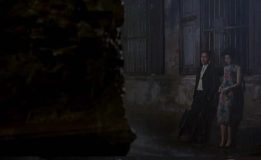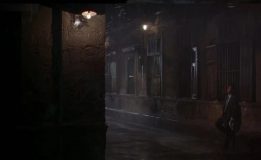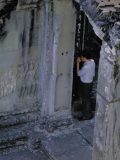IN THE MOOD FOR LOVE, DIR.Wong Kar Wai (2000)
Central Street, Hong Kong; Angkor Wat, Cambodia
The film was shot and edited in a collage of corridors, streets, corners and other fragmented spaces in Central and Sheung Wan in Hong Kong and Bangkok in Southeast Asia. As a result, the film is not very coherent, but rather gives the director and actors more freedom to play.

(A scene where the hero and heroine are talking in dim light)
The spatial setting is an important factor in the development of the film. The scenes are covered by dim lighting and cold-toned walls, giving a depressing and sentimental atmosphere. In the narrow space and depressing environment, the hero and heroine release their inner depression. At the same time, it also conveys the hazy and vague emotions and inner turmoil of the two characters. The contrast between cold and warm also displays the psychology of the characters in the same way, laying the groundwork for the extra-marital ambiguity that follows. The scene in which the man and woman talk to each other in front of a rusty barred window, with a striking red line on the mottled wall, hints at the morally insurmountable bondage of the man and woman’s relationship. Furthermore, the camera is shot from the corner, using a masking composition to give the viewer a voyeuristic perspective and a mysterious aesthetic. By using simple spatial scene settings, director Wong Kar-wai is able to focus the audience’s attention on characterization and plot.
The location at the end of the film was filmed at the temple of Angkor Wat in Cambodia. There is only the male protagonist in the scene at this time, and the bright and cool lighting contrasts with the dim light in front. In the scene, the male protagonist only occupies a small part of the space, and most of the Angkor Wat is displayed. With such space setting and lighting treatment, it implies the tragic ending of the story and the ending without a chance.
(The scene where the hero talks to the temple wall)
In fact, Wong Kar-wai’s flexible use of camera, spontaneous narration and screen to suggest the film’s ambiguous mood that cannot be exported. The broken scenes and gloomy lighting create the emotional sorrow of the male and female protagonists. A unique spatial setting and darkness of tone in this film is used to portray the characters and the theme of fruitless love. The hero and heroine want to love but do not have the courage to want to love, suggesting the complex relationship between society, human nature as well as, emotions, and morality. What attracted me most in this film is the nostalgic feeling of the film’s atmosphere and space setting, creating the reality of Hong Kong society and environment in the 60s. Meanwhile, the audience can be better brought into the main character’s regretful emotions.
Ziqian PENG (3035946617)
Your film analysis is thoughtful and includes references to visual techniques such as lighting and composition. You also brought in concepts like the voyeur and contrast. However, you should also be describing how the space is like in reality, and comparing it to its portrayal in the film. Did you conduct any virtual field-trip? Can you clarify how the recreation of Hong Kong’s environment in the past is helpful in engaging the audience’s emotions? Perhaps, focusing on just one of the spaces could make for a deeper analysis. Finally, you are also reminded to cite any references used.